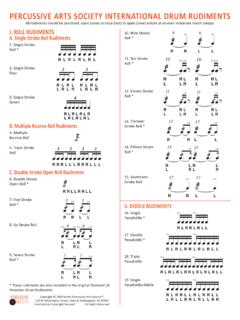Transcription of Traditional Drum Rudiments - Youngstown State University
1 Traditional drum Rudiments Commonly utilized snare drum Rudiments were collected, standardized, and published in the 1940 s by the National Association of Rudimental Drummers ( ). Their list consisted of twenty-six Rudiments divided into two categories; the essential 13 Rudiments and 13 additional ones. The essential 13 consisted of three double stroke Rudiments , four flam Rudiments , and six drag Rudiments . Curiously, such fundamental Rudiments such as the single stroke roll and the single- paradiddle were omitted from their essential list, but were included on the additional 13 list. These lists are still used in many states for the required rudiment portion of adjudicated snare drum events.
2 In an effort to further standardize and disseminate rudimental information, the Percussive Arts Society published, in 1984, an expanded collection entitled Percussive Arts Society International drum Rudiments . The PAS list represented a major improvement that grouped the Rudiments by the type of sticking motions. The PAS list continues to serve as the most important list for most percussionists and is available at Since the early 1980 s drum corps percussionists have continued to compose numerous hybrid- Rudiments and several published lists of hybrid Rudiments are now available. For more information see the following websites: History and Interpretation of drum Rudiments Russ Girsberger, formerly with the United States Marine Band in Washington, , has compiled a list of books related to rudimental drumming.
3 He covers rudimental drumming in the United States, other national styles of rudimental drumming, specific rudiemtal drum solo, and interpretation and practice of the p Rudimental drum Club, The The Rudimental drum Club homepage offers an amazing amount of information. Their goal is to teach you the fine art of Rudimental Drumming - from the basic strokes to the most advanced inverted combinations. There are play along midi files that will challenge & inspire you, videos to watch and learn from, suggestions to read and think about, and even stuff to download and print out. rudimental drumming webpage New and improved rudimental drumming webpage, now has video clips pop Revisiting a 'bridge' to the Ancients__Looking back at Sanford A Moeller Remembering " Traditional " article covering Sanford A Moeller's (AVI examples) How to practicing Rudiments : I think there are two beneficial ways to practice Rudiments .
4 One is at fixed tempi and the other is through a range of tempi slow to fast to slow. The slow-fast-slow method, the Traditional method, is required at State music contests or adjudicated snare drum events and many auditions, and is the most succinct way to demonstrate tempo flexibility, speed, and endurance. However, considerable time must be spent playing Rudiments at fixed tempi in order to fully develop your technique. In fact, my recommended process for playing Rudiments slow-fast-slow actually includes a combination of these two approaches. Observing this process will help you avoid many of the common problems associated with the slow-fast-slow approach.
5 Three of these include: 1. the volume increases as the speed increases and vice versa, 2. the musical form is not symmetrical often the accelerando portion constitutes far more than 50% of the elapsed time, 3. different Rudiments are played for dramatically different lengths of time. Phase 1. Determine a rudiment , rhythm pattern, measure signature, and phrase length. Play the exact same number of repetitions at a series of distinct tempi ascending and descending in 4-6 beat per minute metronome increments. Time this process. Your goal should be to identify how many repetitions it takes to complete a one or two minute symmetrical slow-fast-slow process.
6 In other words you should reach your maximum controllable speed at the halfway point in time. Once this is mastered you should move to phase 2. Phase 2. Determine a time length such as two minutes. Determine how many repetitions you will need at each tempo. Gradually transition from one tempo to the next without an identifiable sudden increase or decrease. Be sure you reach you maximum controllable speed at one minute. I recommend you prepare one minute and two minute versions of each rudiment . Time each one and memorize the amount of repetitions necessary to achieve the desire time frame. Later, play them without watching the clock and check to see how accurate your can become.
7 What to practice: 2 Rather than moving sequentially from numbers 1 through 40 on the PAS list, I recommend that you begin with the most fundamental Rudiments from each family (singles, doubles, flams, drags, multiple bounce), as this assures you will more quickly develop versatility. Initially focus on achieving a high quality with the following phase 1 Rudiments rather than merely seeking to cover all 40. Phase 1. Single stroke roll Double stroke roll, 5 stroke roll, 7 stroke roll, 9 stroke roll Flam, flam tap, flam accent, flam triple (same rhythm as flam accent but triple stroked) Although not on the PAS list, I find this very beneficial. Drag, single drag tap, double drag tap Multiple bounce roll Phase 2.
8 Add several more Rudiments from each family. Etc.










